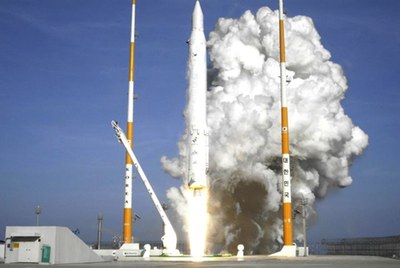How geopolitical factors overshadow South Korea’s space successby Ajey Lele
|
| South Korea has realized its dream of becoming a spacefaring nation at a very delicate period in its history. |
Unfortunately for South Korea, the timing of this launch is a bit peculiar because of the ongoing crisis in the region and also because satellite technology is being constantly getting hammered for its missile angle. (On January 28, Iran launched a monkey on a suborbital spaceflight; this mission is also been viewed as one with a missile angle). In fact, South Korea needs to be congratulated for finally fulfilling its dream of becoming a true spacefaring nation, a nation capable of launching its own satellites, joining only a handful of other nations.
South Korea’s initial attempts to develop a satellite launch system had been unsuccessful. Two previous launch attempts in 2009 and 2010 failed and the latest launch was delayed from October and November of last year. Russia provided first stage of the rocket for this launch; some hardware problems on the Russian end contributed to those delays. It appears that South Korea will take few more years to develop a truly indigenous launch vehicle.
South Korea, Asia’s fourth largest economy, has made significant developments in various technology-intensive commercial sectors, from automobiles to mobile telephony to semiconductors. By comparison, they took far more time to achieve success in space field. North Korea has recently accepted that its long-range rockets have both scientific and military uses. Naturally, the same question could also be raised in regards to South Korea. However, because South Korea is an active participant in various international non-proliferation regimes, its intentions are not questionable. In fact, South Korea, in spite of being an ally of the US for many years, was not granted space technology knowhow required to develop launch vehicles. The US had fears that such technology transfer could allow South Korea to develop a missile program that could lead to an acceleration of an arms race in the region with North Korea. Finally, South Korea joined the Missile Technology Control Regime (MTRC) in 2001 and subsequently established a space collaboration with Russia. In spite of that, it took more than a decade for them to put a launcher system in place. During last few years they have put more than ten satellites in orbit with the assistance of nations like US, Russia, and Japan.
South Korea has realized its dream of becoming a spacefaring nation at a very delicate period in its history. For the healthy growth of their space program, they would have to maintain a precarious balance during this phase of provocative politics. Presently, they are facing several short-term and long-term dilemmas that could have either a direct or indirect bearing on their space program.
| South Korea’s stated ambitions in space do not match with reality. |
First, their recent success has come in the midst of increased tensions in the region. The geopolitical situation is not conducive to the strong growth of technology and there exists a possibility that space could be used as a pawn in the larger strategic games being played in the region. Many believe that a few of South Korea’s existing civil remote sensing satellites are capable of providing inputs to military forces, and Koreasat-5, launched in 2006, has an integrated communication system for military purposes. They may also be receiving intelligence inputs from Japanese and US satellite systems. However, learning from the case of Japan, which in 2009 amended its space policy and developed a network of spy satellites, there could be internal pressures to make immediate alternations in the space agenda and invest in reconnaissance satellites.
Second, South Korea’s stated ambitions in space do not match with reality. Under its present agreement, Russia will provide South Korea the first stage for three rockets only. Naturally, their first task should be to develop a totally indigenous three-stage rocket. They have plans to develop that launching system by 2020 and, by 2025, they propose to land a probe on the Moon’s surface. Definitely, it is going be challenging for them to achieve these deadlines. Also, they have ambitions of joining the satellite launch market. All this is possible only if they succeed in developing a reliable launch vehicle to carry medium and heavy satellites. Failing to realize this dream (in time) could hurt their commercial interests. China and India have already established themselves in this field, and the challenge for South Korea is to first quickly develop a reliable system, and then attract customers. Also, any further glitches with their space program would be a loss of face for a state known for its technological primacy, especially if North Korea has future space launch successes.
Many observers expect that North Korea could conduct a nuclear explosion that would coincide with former ruler Kim Jong-Il's birthday on February 16. There are some unconfirmed reports that China is proposing to carry out an ASAT (anti-satellite) weapon test in the near future. China could conduct such test during the same period of the North Korea’s nuclear test to divert attention. All this could increase the US presence in the region and South Korea may get trapped in the power politics of the two big nations. Unfortunately, in the Korean peninsula, space technology, something with great socioeconomic relevance, is instead being used primarily for political reasons.
